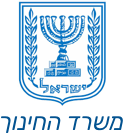A wonderful exhibit that shed light about a lesser known period of “light and darkness”
The honorable Japanese ambassador sat and stared at the presentation, as if history was standing before his very eyes.
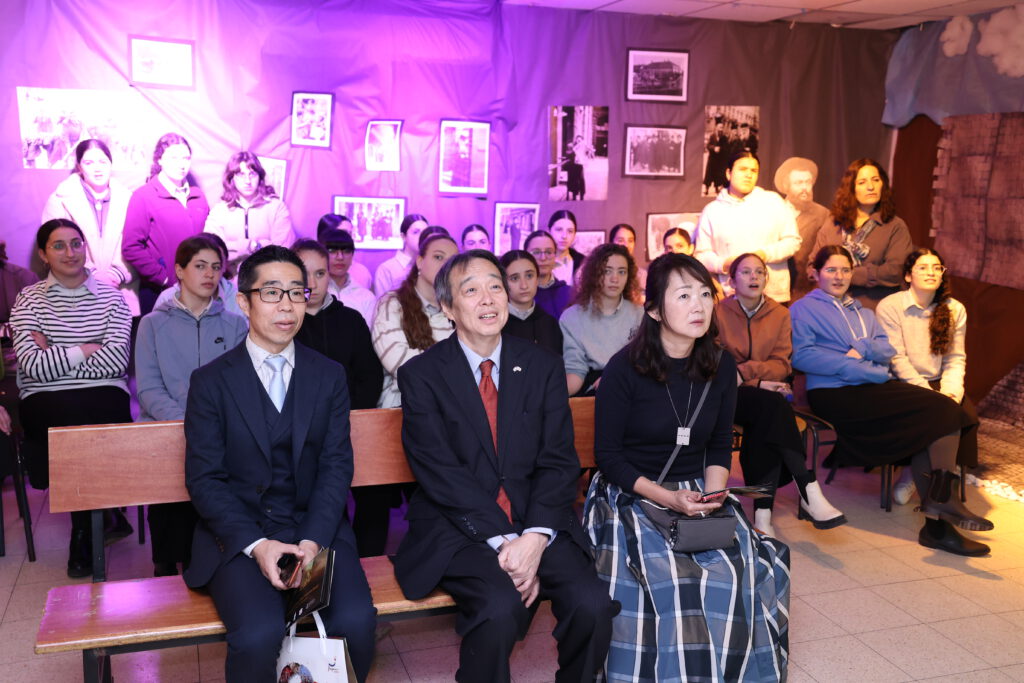
The students played their roles with great talent. The Japanese ambassador, Mr. Mizushima Koichi and his wife, accompanied by their entourage, listened to the professional translation of the presentation, but it was evident that they understood the language of the heart even better.
“The Journey to Shanghai”, was the name of the unique project, the result of a wonderful collaboration between Ganzach Kiddush Hashem and the Beit Chana Chabad (Lubavitch) high school in Jerusalem.
On March 4th, the school was given a new appearance. The building was transformed into a Japanese enclave, or rather a “Shanghai”, in the middle of the holy city of Jerusalem.
Geographically, the Beit Chana school is very close to the Mir Yeshiva, maybe a three minute walk separates them. The Mir Yeshiva is the yeshiva that historically is most associated with the escape to Shanghai. On the other hand, to the east of the school, is the Old City and the Western Wall, to which the refugees in Shanghai thought about both day and night. The Lubavitcher chassidim, who were also refugees in Shanghai, and their Torah-oriented, chassidic, and yeshiva activities there, will never be forgotten.
Suddenly, Shanghai came to life and began to tell its unknown story.
Ganzach Kiddush Hashem provided the tools, documents, historical data, and the pedagogical guidance, with many years of experience. The students of Beit Chana, under the direction of the educational staff, set up the exhibitions and performed, this after months of fruitful study.
The result: a miraculous rescue mission, crossing countries and continents, took shape and came to life before the amazed eyes of the many visitors, including prominently, as mentioned, the Japanese ambassador to Israel and his entourage.
The journey was divided into five stations, and at each one, the students presented the war refugees in a natural and touching way.
Station 1
Poland – a country bustling with a lively and cheerful Jewish life until the outbreak of the war – and the dilemma of escape.
The show and the exhibition changed from bright and pleasant colors, which expressed a happy and calm everyday life, to somber colors, dark backgrounds, and images of destruction and harsh decrees.
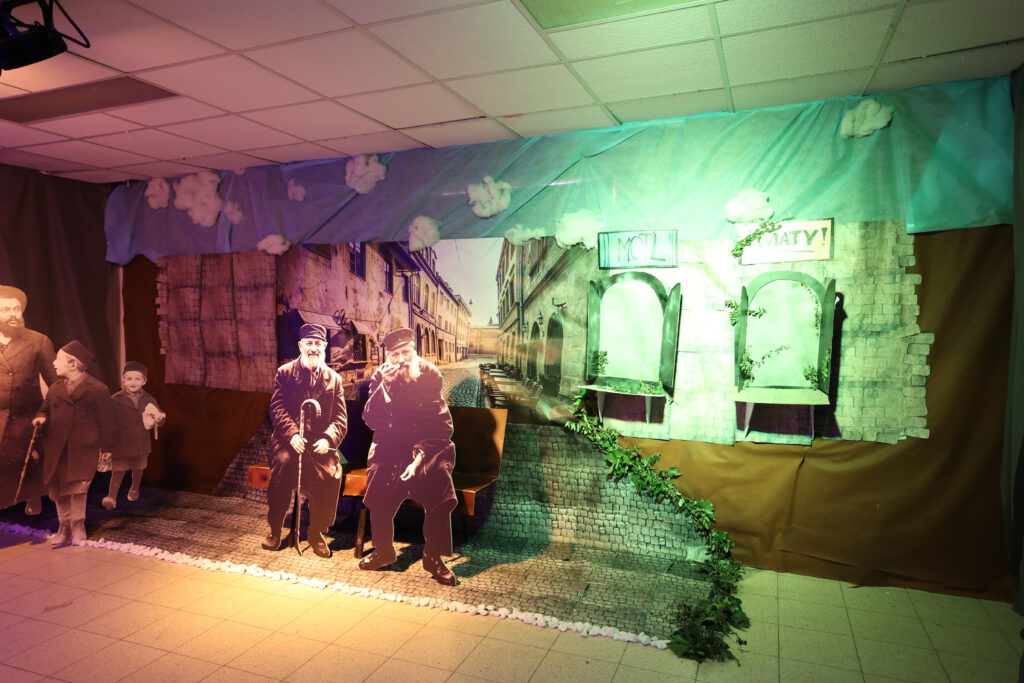
In this section, a heartbreaking film is shown in which two yeshiva students are seen debating and struggling with where they will escape too, and how they will leave their families.
Station 2
Vilna – a (temporary) place of refuge for the Torah world.
We walked into a hall full of books, in the center of which was a Torah scroll lying in “flames.” A heated discussion arose among those present about the possibilities that faced those fleeing, what was the meaning of the escape to Vilna – a city that represented the world of Torah, and what was the meaning of the Torah that the wicked were threatening to burn?What does the Torah book represent for us, and what are Jews willing to do to save the Torah from the flames?
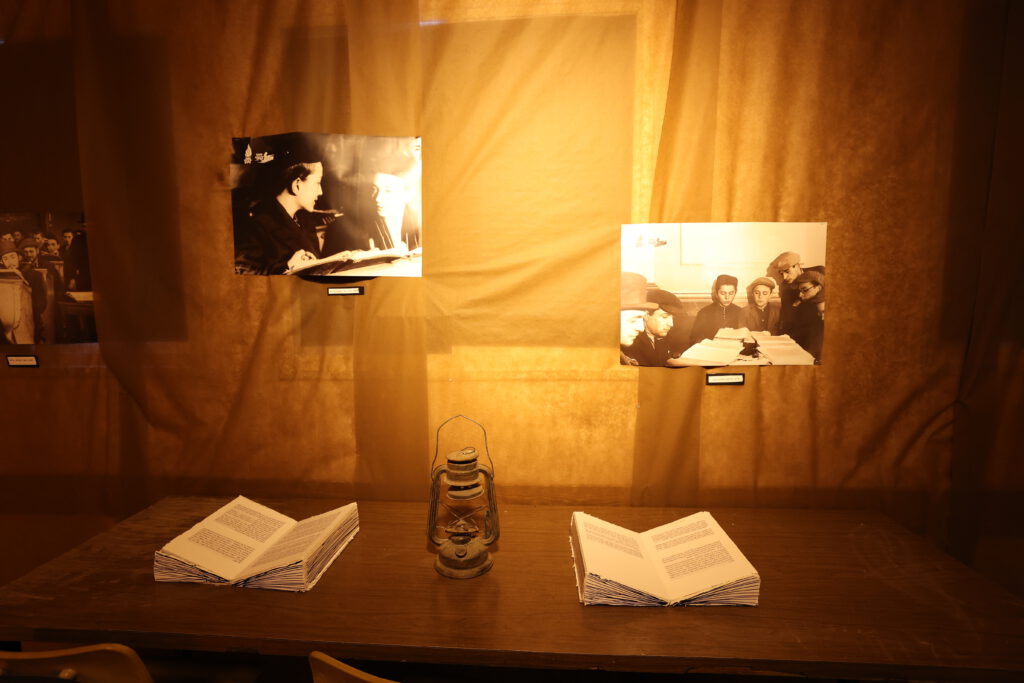
In this station, by visual means, we were told about the young men’s escape journey to Vilna, about the reception of those who observed the Torah and their support for the refugees, and about their decision to flee further.
Station 3
Kovno – here shines the light of the Righteous Among the Nations, Chiune Sugihara, whose name was often mentioned during the days of the “Rise from the Dust” exhibition.
This room was painted and decorated with Japanese motifs: landscape photos from Japan, the Japanese green colour, Japanese flags, and a cart full of traditional Japanese food (sushi).
At the front, stood a a real photo of the fence, beyond which Jews stood waiting to receive a visa.
In this room, the amazing story of the Righteous Among the Nations, the Japanese consul in Lithuania, Mr. Chiune Sugihara, who lived in Kovno at the time, is told. Spectacular video clips and presentations tell the amazing story of the rescue, and here, we can say, we detected real excitement on the face of the Japanese ambassador and his companions.
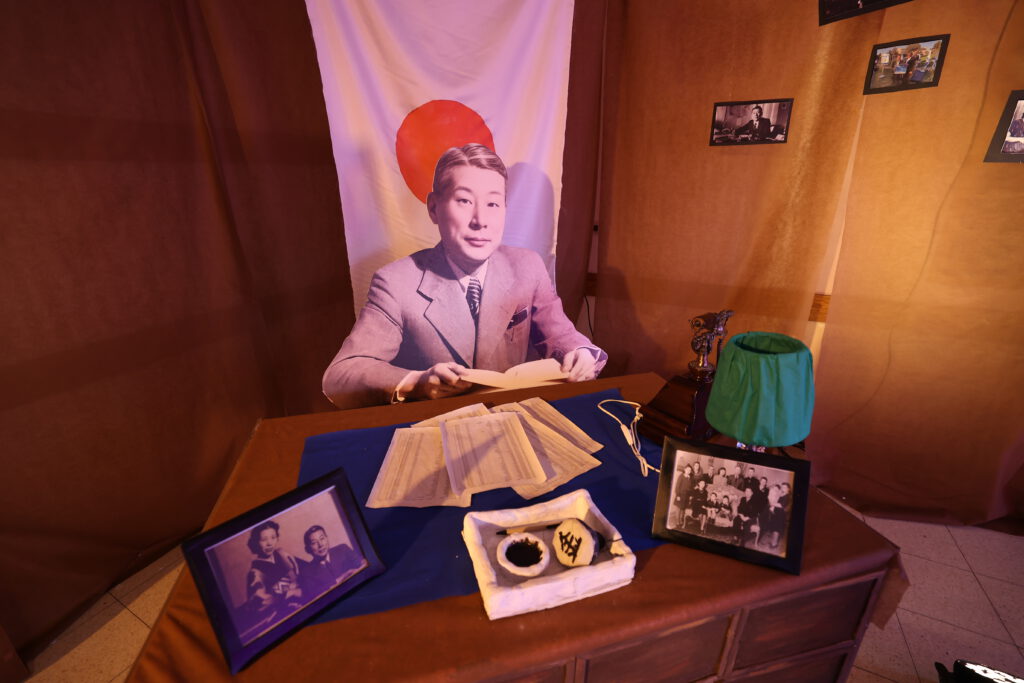
In a particularly moving segment, a large and branched family is observed, all descendants of one man who was saved from death thanks to the visa granted to him by the Japanese consul, Mr. Sugihara. They all look at each other with tears in their eyes and say: “Thank you.”
Thanks to Sugihara’s visas, thousands of Jews were saved. At the climax of the performance, Sugihara’s Righteous Among the Nations “certificate” ws presented to the ambassador, to the applause and excitement of those present.
Station 4
“Between the Railways and the Waterways” – the ways of rescue
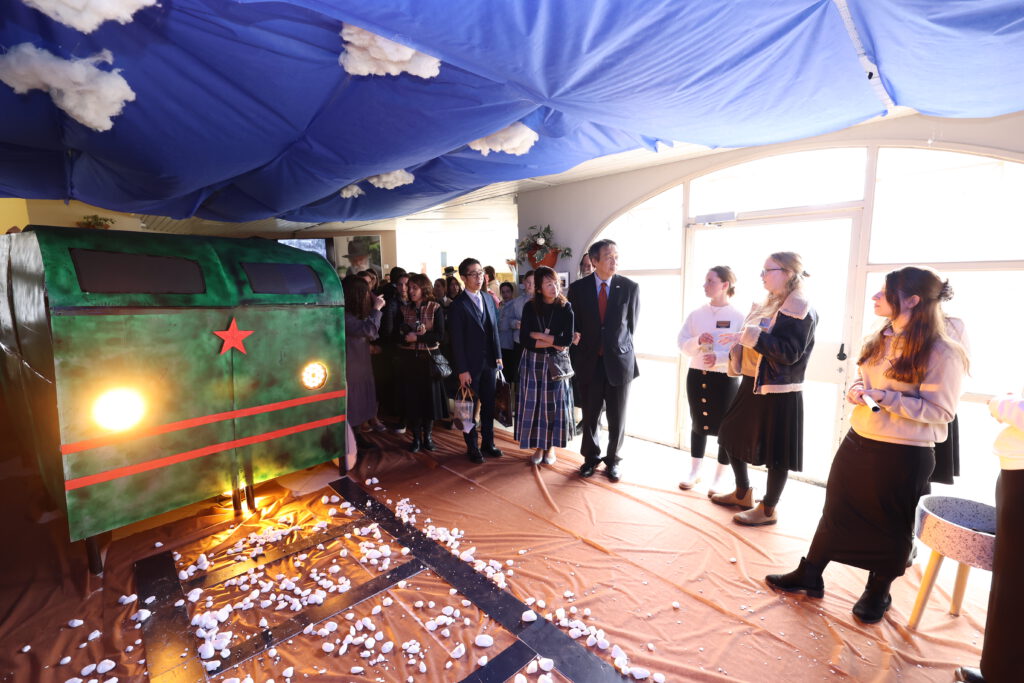
A transcontinental journey, which began with a train car (those present were surprised to suddenly discover a train car built especially for the exhibition) and continued by ship to the shores of Japan (the ship built by the students of Beit Chana is similar to the ship on which the refugees sailed eighty years ago, from Lithuania to Japan).
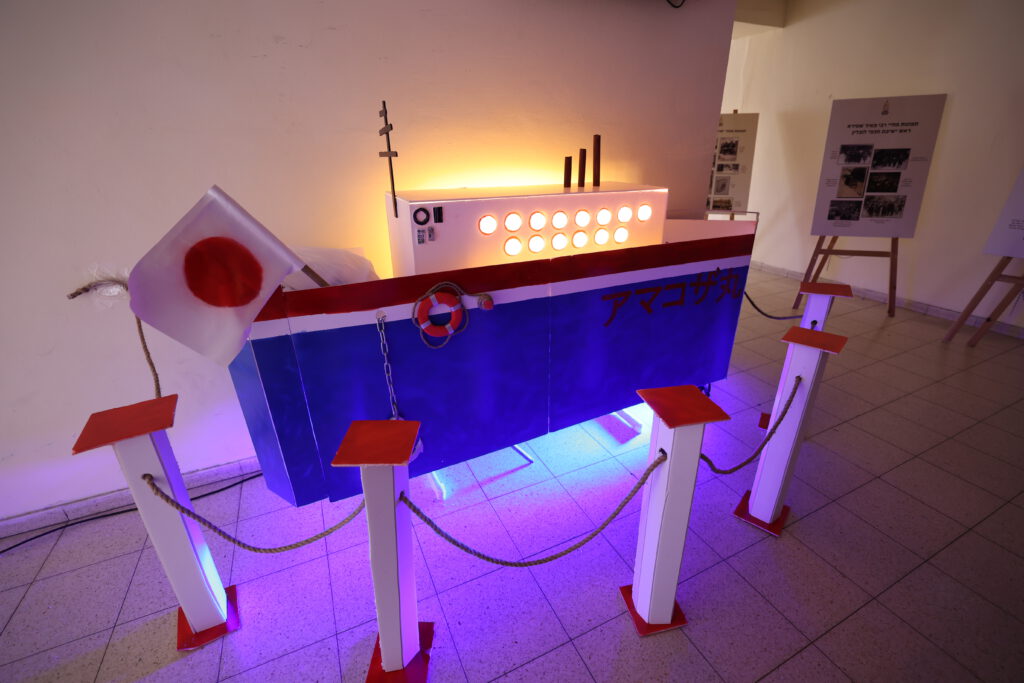
Station 5
Shanghai – The Torah world found rest in the big city and in the alleys of the ghetto.
In the center, was a model of the city of Shanghai with its various districts and the synagogues where the refugees found rest, as well as a model of the ghetto district, and more.
All around were life-sized figures from life in Shanghai during that fateful period.
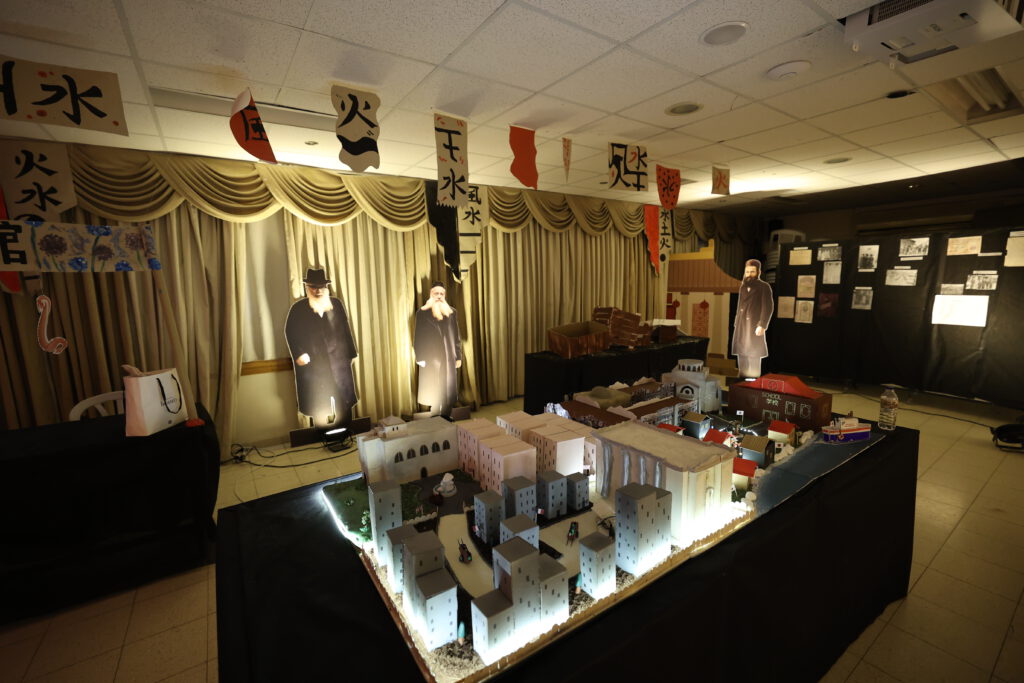
A presentation projected on the wall told, in an exciting and tangible way, the story of six historical figures of Shanghai. The Shanghai atmosphere of eighty years ago filled the dark room, and especially the hearts of the viewers: the routine of a Bais Yaakov school student, a refugee in Shanghai, and the nature of her struggles; the Amshinover Rebbe who also lived in Shanghai and breathed into it the spirit of Torah and chasidism; the chassid, Rabbi Meir Ashkenazi, the rabbi of Shanghai, and his extensive activities in all areas related to Torah, kindness, and helping others; the genius, Rabbi Chaim Shmulewitz, the head of the Mir Yeshiva; a righteous convert to Judaism who discovered his people and G-d during this period; and a Japanese officer who was in charge of the Jews in the ghetto.
The exhibition, with its many presentations and elaborate screenings, is a perfect production full of hope, faith, and gratitude.
In addition to the exhibition created by the girls, there were also mobile exhibits from Ganzach Kiddush Hashem, which added a rich and emotional historical Jewish touch and were meaningful and interesting. One such exhibit was the “Light from Lublin” exhibit that decorated the space of the third floor and in the center of it was the miniature and illuminated model of the building of the Chachmei Lublin Yeshiva. Many young men from the students of the yeshiva, and this is already the subject of a special article, also found refuge in Shanghai.

Yeshiva students in Shanghai (From the book “Derech Eretz Seen,” courtesy of The Librarians blog)
Here is an excerpt from the press of the time about the influence of the Lublin students on the Jewish community in Shanghai (“HaTzofeh” newspaper, October 29, 1946):
The masses of refugees were alienated from Jewish values, especially the desecration of Shabbat, but the situation changed for the better in 1941, when over 1000 Jewish refugees from Poland arrived in Shanghai, over half of them rabbis and yeshiva students… under the influence of the yeshiva students (namely: the Mir Yeshiva, the Lubavitch Yeshiva, and the Chachmei Lublin Yeshiva) and their institutions, 350 boys and girls created a revolution in their parents’ homes and convinced their parents to close their shops on Shabbat, install a kosher kitchen at home, and break all the unkosher utensils. Thanks to them, the face of the Jewish community in Shanghai changed completely.
The administration of the school, led by the principal Rabbi Peretz Beloy, which took an active part in all of the stages of the preparation and production, movingly expressed their gratitude and appreciation to the professional staff of Ganzach Kiddush Hashem for their guidance, for providing the material with endless kindness and patience, for the detailed explanations, and in general, for a listening hear and for sticking to the goal. From the bottom of their hearts, the administration thanked the CEO of Ganzach Kiddush Hashem, Rabbi Zvi Skulsky; the COO, Mrs. Rachel Yud; and the production coordinator Mrs. Tova Yoskovitz, for the joint initiative and initiating the connection, which was crucial to the historical educational production, whose results were evident to the hundreds of students during the entire time of study and preparation, and especially on the days of the exhibition, when they reaped the fruits of their labour.
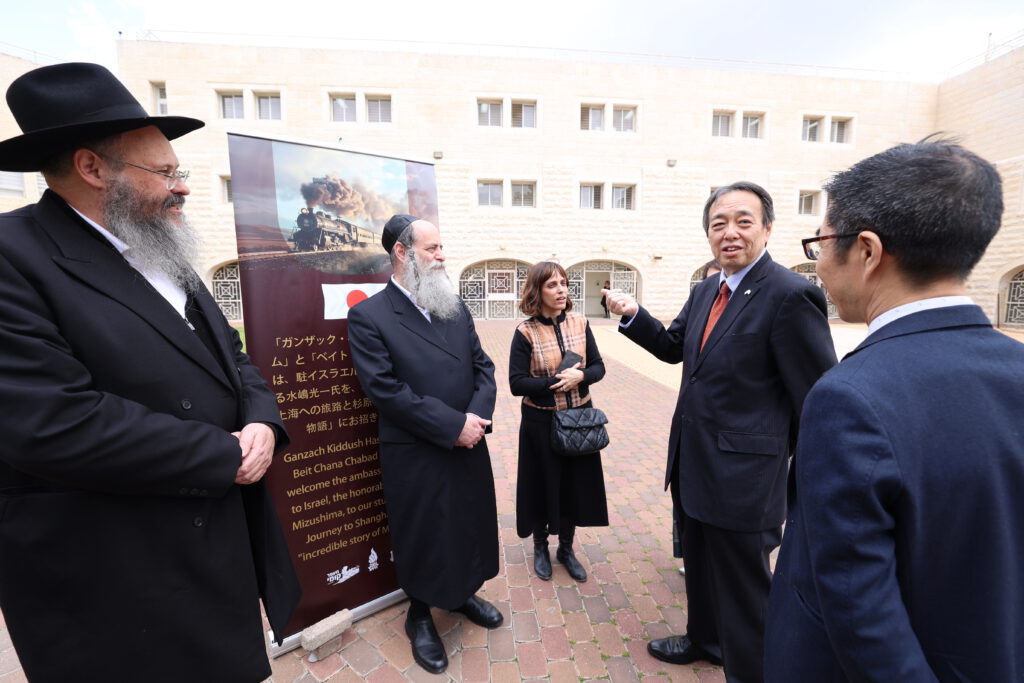
The ambassador and his entourage spent long hours within the walls of the school, and when it was time to say goodbye, he wished to express his feelings. In his short words he told about his sympathy for the Jews and his interest since his youth in the Jewish people and its history. “Today I saw in a tangible way what I learned many years ago.” He praised the wonderful work and the clear and professional presentation of the historical materials that is so necessary, lest they be forgotten.
Ms. Batsheva Porat from the Claims Conference in Jerusalem, who came to be impressed by the activity, praised the involvement of the students in setting up the exhibits and running the entire study day, a fact that resulted in significant learning and a deeper understanding of the material.
At the end, Mrs. Rachel Yud, stated that the great success of the exhibition is due to the fact that the team of teachers, led by the history coordinator Mrs. Malka Eisenbach and the teacher, Mrs. Lichtschein, together with select students, worked hard day and night in full cooperation with Ganzach Kiddush Hashem’s team. The combination of the school’s teaching staff with the educational staff of Ganzach Kiddush Hashem was a recipe for success.


